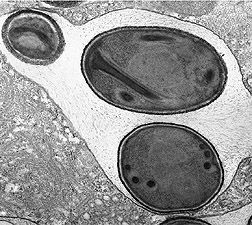Managing Disease in Beneficial Insects
|
|
Beneficial insects are used in biological control programs in environmentally sound and effective ways to stop unwanted insect pests or other organisms from affecting agriculture. These insects are mass-reared to ensure that a steady supply is available for researchers and farmers.
But what if these beneficial insects become infected with disease—as happened recently with two species of weevil? They're too valuable to kill or let die, and they're in demand to control harmful pests.
ARS's Invasive Plant Research Laboratory in Fort Lauderdale, Florida, screens beneficial insects for use against invasive, nonnative plants. James J. Becnel, an entomologist at ARS's Center for Medical, Agricultural, and Veterinary Entomology in Gainesville, Florida, and Theresa Rebelo, a postdoctoral researcher from Portugal, worked with the laboratory to determine what was infecting the beneficial weevils.
They suspected a newly discovered microsporidian species was harming two closely related South American weevils (Neochetina eichhorniae and N. bruchi) used since the 1970s to control water hyacinth, an exotic aquatic weed clogging waterways and wildlife habitats. The research team determined that the microsporidia were decreasing weevil survival rates by 30 percent and reducing reproductive capacity by 72 percent in one weevil species and 62 percent in the other.
This demonstrates the types of problems that can occur when organisms used in biological control programs are sidelined with disease. If it's determined to be economically practical to treat weevil colonies, researchers will have to develop a method to cure them of the disease.
"There are different approaches to treating diseases in beneficial insects," Becnel explains. "Often, combining treatments works best to extend the window of opportunity for the therapy to take hold in a colony."
The Pasteur method is one way to eliminate disease in insect colonies when infection rates are low. This method screens out infected eggs and adults, leaving only healthy ones for the colonies. Another method uses heat shock to cure insects of disease, an effective tool for eliminating some microsporidian species but not others. Cold treatments have also been used because the healthier insects in a colony can develop more quickly than infected ones when exposed to low temperatures. They can then be separated from sick ones.
Several different approaches to controlling disease have been studied in Gainesville. Nosema disease of parasitoids is a serious problem affecting insect integrated pest management programs. The disease shortens the life of parasitoids and reduces their fertility and fitness.
Two parasitic wasp species used to target house and stable flies were infected by a microsporidium in the Nosema genus. Becnel, another ARS entomologist with the ARS Mosquito and Fly Research Unit, Christopher J. Geden, and cooperators found a way to treat female wasps' food with different drug therapies, which lessens the disease's spread to their offspring. This treatment was very effective when combined with short exposure of infected parasitoids to high temperatures.—By Jim Core, Agricultural Research Service Information Staff.
This research is part of Arthropod Pests of Animals and Humans, an ARS National Program (#104) described on the World Wide Web at www.nps.ars.usda.gov.
James J. Becnel and Christopher Geden are in the USDA-ARS Mosquito and Fly Research Unit, Center for Medical, Agricultural, and Veterinary Entomology, 1600 S.W. 23rd Drive, Gainesville, FL 32608; (352) 374-5961 [Becnel], (352) 374-5919 [Geden], fax (352) 374-5966.
"Managing Disease in Beneficial Insects" was published in the April 2004 issue of Agricultural Research magazine.







